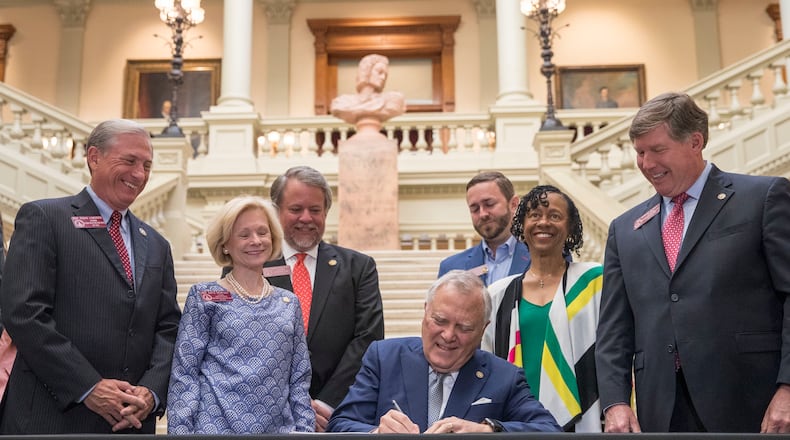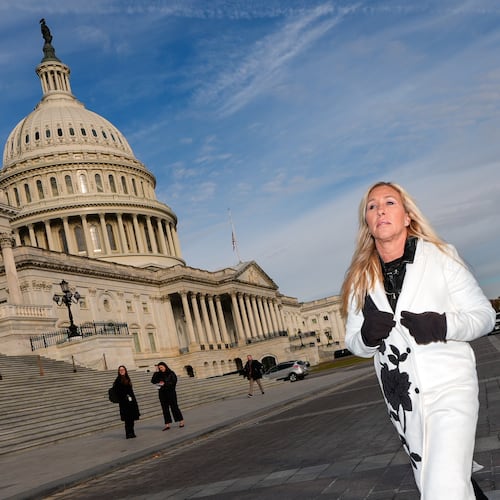Five months before he leaves office, it appears Gov. Nathan Deal has met one of the most important promises he made to his successor.
Unlike the past two governors, Deal won’t leave Republican Brian Kemp or Democrat Stacey Abrams with little in the way of a financial safety net.
The latest estimates are that the state now has about $2.5 billion in its savings account, a record amount Deal promised to hit before he leaves office in early January.
Deal began rebuilding state reserves after coming into office in 2011 facing a recession-drained budget and only a few days’ worth of savings.
His predecessor, Gov. Sonny Perdue, had faced similar problems when he took office in 2003 following the post- 9/11 slowdown.
The state is expecting a windfall this year from the federal tax law Congress passed in December and a recent U.S. Supreme Court ruling allowing it to collect sales taxes from internet retailers, so the next Georgia governor was already going to have a cushion.
But those who had to govern through the Great Recession — with employee layoffs and furloughs for teachers — said Deal’s accomplishment in saving for the next downturn shouldn’t be overlooked.
“The next governor owes Governor Deal a great debt,” said former House Appropriations Chairman Ben Harbin, now a Statehouse lobbyist. “If there is a downturn, they are going to be able to manage it with a lot less headaches.”
The growing economy of recent years has caused some to forget how recessions buffeted the state in the first half and later stages of the 2000s and into the 2010s.
Gov. Roy Barnes was already paring spending in 2002 when he was upset by Perdue, the first Republican to hold the office since Reconstruction. Perdue called for a mix of further spending cuts and tax hikes to stabilize the financial situation, but lawmakers bucked against some of his proposals.
In the end, the state cut spending, passed a cigarette tax hike and continued to drain reserves. At points, there was a day’s worth of state spending in the reserves, maybe less.
When the economy improved, Perdue and lawmakers rebuilt reserves, only to get hammered by the Great Recession in his second term. Again, lawmakers largely eschewed tax increases, cut spending and spent reserves.
The Great Recession hit Georgia harder that the previous downturn. Teachers — those that didn’t get laid off — often saw their pay decline because they were forced to take days off without pay. State employees were also let go, and hiring for most agencies stopped. Less money was sent to school districts, colleges, the park system and others to operate.
Current House Budget Chairman Terry England, R-Auburn, said it costs about $2 billion a month to run state government. At times in 2010, there was the equivalent of about two days' worth of state spending in the bank.
Among other things, England said having an empty piggy bank endangers the state's top bond rating. A lower bond rating means taxpayers pay millions of dollars more each year in interest to borrow money for new schools, roads and bridges, and college buildings, state officials say.
“A big reason we have the AAA bond rating is we have been able to put money back into the rainy day fund,” England said.
In the Great Recession, England said, the state was able to continue providing services in part because of the reserves built up during the Perdue administration. “The cuts would have had to be much deeper,” he said.
Jim Malatras, the president of the Nelson A. Rockefeller Institute of Government and a former director of state operations under New York Gov. Andrew M. Cuomo, said states across the country have been rebuilding reserves in recent years, although some still don’t have what they did before the Great Recession.
The national average for states is having about 30 days’ worth of spending banked, he said. Georgia is ahead of that curve now.
“States need to have that cushion, especially with some seeing lower-than-projected revenue growth,” he said. “It’s not the sexiest thing. … It is really a key piece, and many states are beefing up their reserve funds.”
SAVING FOR A RAINY DAY
Gov. Nathan Deal has made it a priority to build state reserves in case of an economic downturn. In past recessions, the state has had to furlough teachers, lay off staffers and cut programs while eating through its savings. Below are the state’s end-of-year reserves:
Fiscal 2002
$ 700 million
Fiscal 2003 (Gov. Sonny Perdue takes office partway through fiscal year)
$260 million
Fiscal 2004
$51.5 million
Fiscal 2005
$256.6 million
Fiscal 2006
$792.5 million
Fiscal 2007
$1.54 billion
Fiscal 2008
$565.9 million
Fiscal 2009
$103.6 million
Fiscal 2010
$116 million
Fiscal 2011 (Gov. Nathan Deal takes office)
$328.4 million
Fiscal 2012
$377.9 million
Fiscal 2013
$717.3 million
Fiscal 2014
$862.8 million
Fiscal 2015
$1.43 billion
Fiscal 2016
$2.03 billion
Fiscal 2017
$2.30 billion
Current
*$2.5 billion
* Preliminary estimate
Source: Governor’s Office of Planning and Budget
About the Author
Keep Reading
The Latest
Featured





